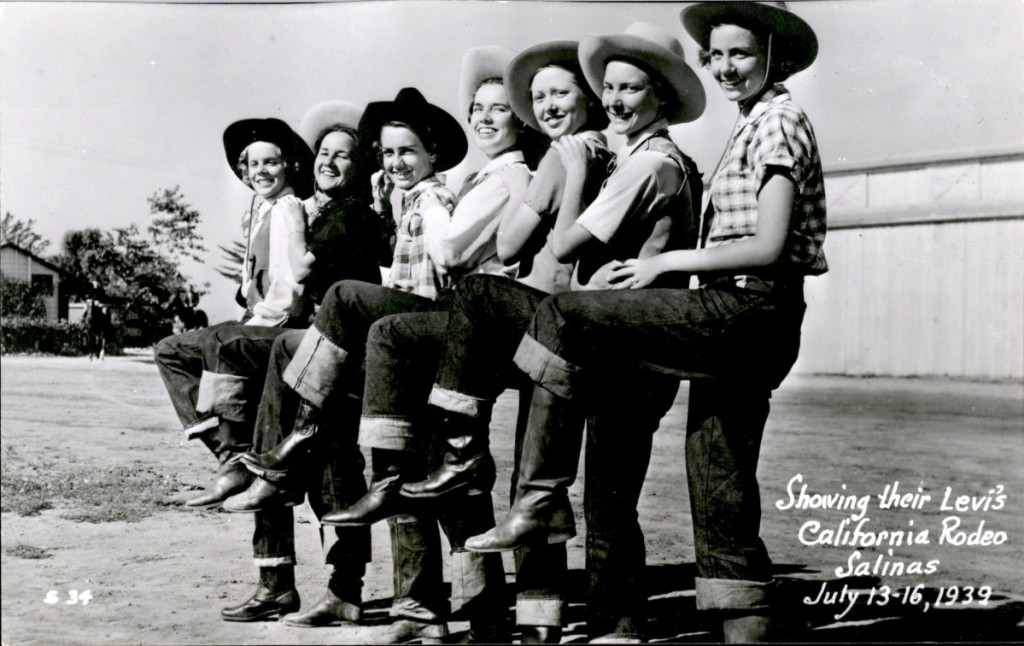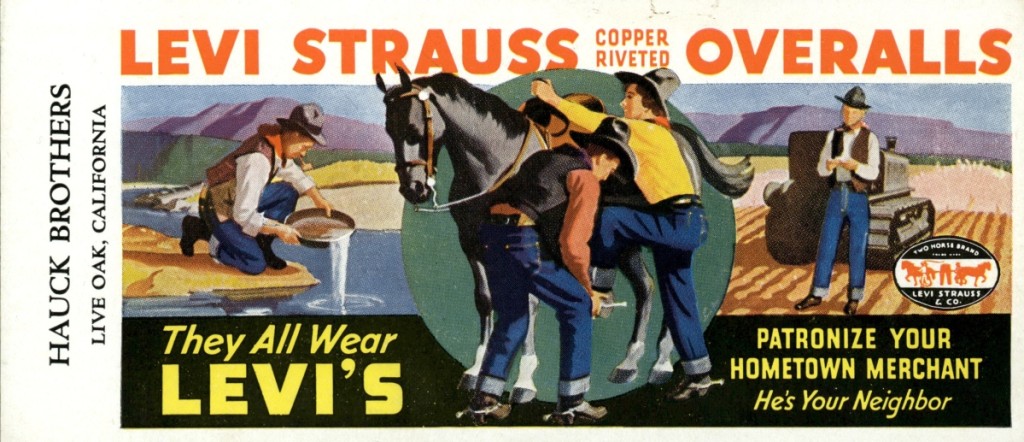
“Showing their Levi’s” postcard from the California Rodeo, Salinas (July 13–16, 1939), 1939. Levi Strauss & Co. Archives.
By Karla Klein Albertson
SAN FRANCISCO – “Levi Strauss: A History of American Style,” which just opened at the Contemporary Jewish Museum (CJM) in San Francisco, displays more than 150 items from the famous firm’s archives – everything from style-setting garments to promotional ephemera and vintage photos. Visitors will see an 1889 advertisement for the “Patent Riveted” pants, images of cowboys and cowgirls showing off their gear and a 1970s denim suit worn by Lauren Bacall. For work or play, in boom times and down times, Levi Strauss survived to supply the demand for denim clothing.
Antiques and The Arts Weekly asked curator Heidi Rabben about the show’s origin and she responded, “The idea of an exhibition about Levi Strauss has been a glimmer in the CJM’s eye for a long time. As one of the most influential Jews and figures in San Francisco’s history, and the man responsible for the most ubiquitous item of clothing in the world today, the context could not make more sense for our institution. The exhibition’s story traces both the life and legacy of Strauss, the man, alongside the legacy of his namesake Levi’s blue jeans – both legacies being of core importance to our mission here at the Contemporary Jewish Museum to make the diversity of the Jewish experience relevant to a Twenty-First Century audience by advancing culture, history, art and ideas.”
The story of Levi Strauss (1829-1902) is another fascinating tale of Nineteenth Century immigration and subsequent success in the New World. Strauss was born into an Ashkenazi Jewish family in Bavaria, and when he was only 18, he traveled with family members to New York. There they joined his brothers, who had started a wholesale dry goods company. In 1854, as the Gold Rush drew people to the San Francisco area, Levi moved west, where he sold clothing and supplies shipped from his brothers. Working with Jacob W. Davis, Strauss was able to devise and then patent in 1873 the riveted denim work pants that became the keynote product of the Levi Strauss company. In his private life, he was an important figure of the local Jewish community and an early member of historic Congregation Emanu-El.
As can be seen from the vintage advertisements in the exhibition, the emphasis for product promotion began to shift after the turn of the century from work clothes to western wear. An ad from the 1940s shows a denim-clad couple smooching on horseback. By the time rock and roll arrived in the 1950s, jeans were stylish for both the performers and the audience. Eventually, they became a universal costume in the United States and around the world. Hippies, bikers, Bruce Springsteen and the president on his California ranch could all agree on Levi Strauss jeans. And, of course, on the silver screen, Levi’s have snugly showed off the stars’ assets. In a few cases, they become the focus of the drama – think of that denim jacket in Brokeback Mountain (2005) and weep.
 To bring together such a major exhibition, Rabben was able to turn to company resources: “My co-curator, Justin Limoges, and I were generously granted access to the archives to research the contents, and through that, determine what kind of story we could tell. It became clear very quickly how selective we would need to be due to the wealth and diversity of objects in the archives, but a clear story started to emerge through the materials we found. Once we had a framework and some objects in mind, we worked very collaboratively with Tracey Panek and Laura O’Hara in the archives to find the best items to help illustrate Strauss’ life, from his Jewish roots in Buttenheim, Bavaria, to his patent with Jacob Davis for the first copper-riveted work pants, to his death in San Francisco; and in parallel, to trace the evolution of the blue jeans, from their origin as durable workwear for miners, lumberjacks and other blue collar workers, to the uniform of the American cowboy, to an enduring symbol of contemporary pop and counter culture. We were also incredibly fortunate to work with curatorial advisor Dani Killam to locate a few key garments from outside the archives to crystallize the pervasive influence Levi’s continues to have today, particularly with celebrities and cultural icons.”
To bring together such a major exhibition, Rabben was able to turn to company resources: “My co-curator, Justin Limoges, and I were generously granted access to the archives to research the contents, and through that, determine what kind of story we could tell. It became clear very quickly how selective we would need to be due to the wealth and diversity of objects in the archives, but a clear story started to emerge through the materials we found. Once we had a framework and some objects in mind, we worked very collaboratively with Tracey Panek and Laura O’Hara in the archives to find the best items to help illustrate Strauss’ life, from his Jewish roots in Buttenheim, Bavaria, to his patent with Jacob Davis for the first copper-riveted work pants, to his death in San Francisco; and in parallel, to trace the evolution of the blue jeans, from their origin as durable workwear for miners, lumberjacks and other blue collar workers, to the uniform of the American cowboy, to an enduring symbol of contemporary pop and counter culture. We were also incredibly fortunate to work with curatorial advisor Dani Killam to locate a few key garments from outside the archives to crystallize the pervasive influence Levi’s continues to have today, particularly with celebrities and cultural icons.”
When asked what visitors will experience at the show, the curator explained, “Perhaps the biggest surprise of all is the most obvious thing: that Levi’s original 501 jeans have barely changed since the first pair was patented in 1873. For anything to survive nearly 150 years essentially unaltered and still be as relevant as ever is a truly singular feat. As someone who has lived in San Francisco for 12 years, I completely took for granted that the quintessential American garment, worn by at least 50 percent of the global population on any given day, was born here in this city. San Francisco has undergone a lot of rapid change in the past 20-plus years, but this show is an illuminating reminder that San Francisco has always been a place for outcasts and innovators. From the Gold Rush to the earthquake and fires of 1906 to the Summer of Love to the AIDS crisis, to the dotcom boom and bust, so many important political and social events of the Nineteenth, Twentieth and current Century took place here, and people were wearing Levi’s jeans throughout all of them. It paints a vivid picture of our city as a source and leader of change. Likewise, to be able to tell Strauss’ story here, where he lived and worked for the vast majority of his life, and to understand how deeply influential he was and continues to be to this place and region perfectly demonstrates that this is the most meaningful place to tell his story.”
As this show demonstrates, the collection and study of vintage clothing has made the jump from pop culture to serious scholarship and connoisseurship. Last December’s issue of the magazine Early American Life ran an article, “The Origins of Denim,” illustrated with historic examples and written by Dr. Kimberly Alexander of the University of New Hampshire. In case all this talk about denim rings a bell, readers may remember the November 2019 Antiques and The Arts Weekly review of a Daniel Buck auction in Maine, where vintage Levi Strauss clothing scored honors among the top lots, with a buyer from the Far East making the winning bids. Perhaps it may be time to ransack the closet and pull out grandpa’s jeans and mom’s classic bell bottoms.
The greatest result of this new emphasis on historic fashion is its appearance in museums, where clothes not only make the man, they make popular exhibitions. In New York, the Costume Institute at the Metropolitan always says yes to the dress. Celebrities will walk the gala’s red carpet this year on May 4 in connection with the new show, “About Time: Fashion and Duration,” which runs through September 7, 2020.
Winterthur just closed the immensely successful “Costuming The Crown,” based on the Elizabeth II streaming drama. In London, the Victoria & Albert Museum recently explored vibrant 1960s designs by the legendary Mary Quant.
Back in San Francisco, Heidi Rabben concluded by mentioning her own favorite parts of the exhibition: “Of course this is a very difficult question. The exhibition covers over 150 years of history, and has so many beautiful personal and universal stories embedded within it. We have some very iconic and classic garments in the show, worn by celebrities and luminaries that one can’t help but feel excited by. But I think my favorite moments in the show are the lesser-known, quieter and personal stories of everyday people who wore or used Levi’s in some way. It’s in the enduring effortlessness and simplicity of Levi’s jeans that their appeal lies. Almost anyone, from any walk of life, anywhere in the world has access to Levi’s and can make them their own, and this exhibition celebrates that universality.”
The CJM is located at 736 Mission Street. The museum is a non-collecting institution housed in an adapted historic power substation, originally built in 1907 and expanded in 2008 with a modern structure designed by noted architect Daniel Libeskind. Learn more about the museum and its exhibitions at www.thecjm.org or 415-655-7800.




















